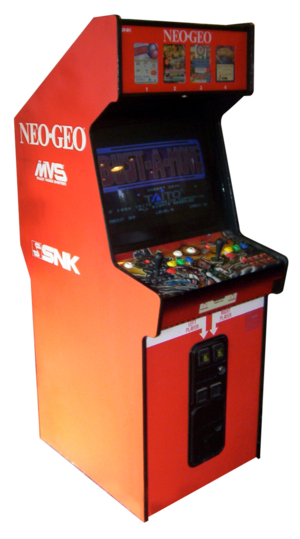Difference between revisions of "Configuration:NeoGeoAES-MVS"
| Line 1: | Line 1: | ||
| + | {{Infobox System|Logo=Neo-Geo mvs logo.png|Image=800px-Neo_Geo_full_on.png|Year=1990|Manufacturer=SNK Corporation|Type=Home video game console|CPU=Motorola 68000 @ 12MHz<br />Zilog Z80A @ 4MHz|GPU=TBA|Sound CPU=Yamaha YM2610|Sound Chip=TBA|Memory= 64KB RAM<br />84KB VRAM<br />2KB Sound Memory|Controllers=Arcade}} | ||
== Platform Information == | == Platform Information == | ||
The Neo Geo is a cartridge-based arcade system board and home video game console released on January 31, 1990 by Japanese game company SNK. | The Neo Geo is a cartridge-based arcade system board and home video game console released on January 31, 1990 by Japanese game company SNK. | ||
The MVS was the stand up arcade version while the AES was the home console version. They both shared the same cartridge type. | The MVS was the stand up arcade version while the AES was the home console version. They both shared the same cartridge type. | ||
| + | |||
| + | ''from wikipedia'' | ||
| + | |||
| + | The Neo Geo (Japanese: ネオジオ Hepburn: Neojio?), stylised as NEO・GEO, also written as NEOGEO, is a cartridge-based arcade system board and fourth-generation home video game console released on April 26, 1990, by Japanese game company SNK Corporation. It was the first system in SNK's Neo Geo family. The Neo Geo was marketed as 24-bit; its CPU is technically a parallel processing 16/32-bit 68000-based system with an 8/16-bit Z80 coprocessor, while its GPU chipset has a 24-bit graphics data bus. | ||
| + | |||
| + | The Neo Geo originally launched as the MVS (Multi Video System) coin-operated arcade machine. The MVS offers owners the ability to put up to six different cartridges into a single cabinet, a unique feature that was also a key economic consideration for operators with limited floorspace, as well as saving money in the long-run. With its games stored on self-contained cartridges, a game cabinet can be exchanged for a different game title by swapping the game's ROM-cartridge and cabinet artwork. A home console version was also made, called AES (Advanced Entertainment System). It was originally launched as a rental console for video game stores in Japan (called Neo Geo Rental System), with its high price causing SNK not to release it for home use - this was later reversed due to high demand and it came into the market as a luxury console. The AES had the same raw specs as the MVS and had full compatibility, thus managed to bring a true arcade experience to home users. As of 2013 it was the most expensive home video game console ever released, costing US$1,125 adjusted for inflation. The Neo Geo was revived along with the brand overall in December 2012 through the introduction of the Neo Geo X handheld and home system. | ||
| + | |||
| + | The Neo Geo was a very powerful system when released, more powerful than any home computer or console at the time, or rival Capcom's CPS arcade system, which did not surpass it until the CPS-II in 1993. The Neo Geo MVS was a success during the 1990s, due to the cabinet's low cost, six ROM slots and compact size. Several successful video game series were released for the platform, such as Fatal Fury, Art of Fighting, Samurai Shodown, The King of Fighters and Metal Slug. The AES had a very niche market in Japan, though sales were very low in the U.S. due to its high price for both the hardware and software; but it has since gained a cult following and is now considered a collectable. Neo Geo hardware production lasted seven years, discontinued in 1997, whereas game software production lasted until 2004, making Neo Geo the longest-lived video game system of all time. The AES console was succeeded by the Neo Geo CD and the MVS arcade by the Hyper Neo Geo 64. As of March 1997, the Neo Geo and the Neo Geo CD combined had sold 980,000 units worldwide. In 2009, the Neo Geo was ranked 19th out of the 25 best video game consoles of all time by the video game website IGN. | ||
=== Media Devices === | === Media Devices === | ||
Revision as of 10:03, 22 May 2016
| NeoGeoAES-MVS | ||
|---|---|---|

| ||

| ||
| Manufacturer | SNK Corporation | |
| Type | Home video game console | |
| CPU | Motorola 68000 @ 12MHz Zilog Z80A @ 4MHz | |
| GPU | TBA | |
| Sound CPU | Yamaha YM2610 | |
| Sound Chip | TBA | |
| Memory | 64KB RAM 84KB VRAM 2KB Sound Memory | |
| Controllers | Arcade | |
| Year | 1990 | |
Platform Information
The Neo Geo is a cartridge-based arcade system board and home video game console released on January 31, 1990 by Japanese game company SNK. The MVS was the stand up arcade version while the AES was the home console version. They both shared the same cartridge type.
from wikipedia
The Neo Geo (Japanese: ネオジオ Hepburn: Neojio?), stylised as NEO・GEO, also written as NEOGEO, is a cartridge-based arcade system board and fourth-generation home video game console released on April 26, 1990, by Japanese game company SNK Corporation. It was the first system in SNK's Neo Geo family. The Neo Geo was marketed as 24-bit; its CPU is technically a parallel processing 16/32-bit 68000-based system with an 8/16-bit Z80 coprocessor, while its GPU chipset has a 24-bit graphics data bus.
The Neo Geo originally launched as the MVS (Multi Video System) coin-operated arcade machine. The MVS offers owners the ability to put up to six different cartridges into a single cabinet, a unique feature that was also a key economic consideration for operators with limited floorspace, as well as saving money in the long-run. With its games stored on self-contained cartridges, a game cabinet can be exchanged for a different game title by swapping the game's ROM-cartridge and cabinet artwork. A home console version was also made, called AES (Advanced Entertainment System). It was originally launched as a rental console for video game stores in Japan (called Neo Geo Rental System), with its high price causing SNK not to release it for home use - this was later reversed due to high demand and it came into the market as a luxury console. The AES had the same raw specs as the MVS and had full compatibility, thus managed to bring a true arcade experience to home users. As of 2013 it was the most expensive home video game console ever released, costing US$1,125 adjusted for inflation. The Neo Geo was revived along with the brand overall in December 2012 through the introduction of the Neo Geo X handheld and home system.
The Neo Geo was a very powerful system when released, more powerful than any home computer or console at the time, or rival Capcom's CPS arcade system, which did not surpass it until the CPS-II in 1993. The Neo Geo MVS was a success during the 1990s, due to the cabinet's low cost, six ROM slots and compact size. Several successful video game series were released for the platform, such as Fatal Fury, Art of Fighting, Samurai Shodown, The King of Fighters and Metal Slug. The AES had a very niche market in Japan, though sales were very low in the U.S. due to its high price for both the hardware and software; but it has since gained a cult following and is now considered a collectable. Neo Geo hardware production lasted seven years, discontinued in 1997, whereas game software production lasted until 2004, making Neo Geo the longest-lived video game system of all time. The AES console was succeeded by the Neo Geo CD and the MVS arcade by the Hyper Neo Geo 64. As of March 1997, the Neo Geo and the Neo Geo CD combined had sold 980,000 units worldwide. In 2009, the Neo Geo was ranked 19th out of the 25 best video game consoles of all time by the video game website IGN.
Media Devices
Available Emulators
Below is a list of available emulators for this platform.